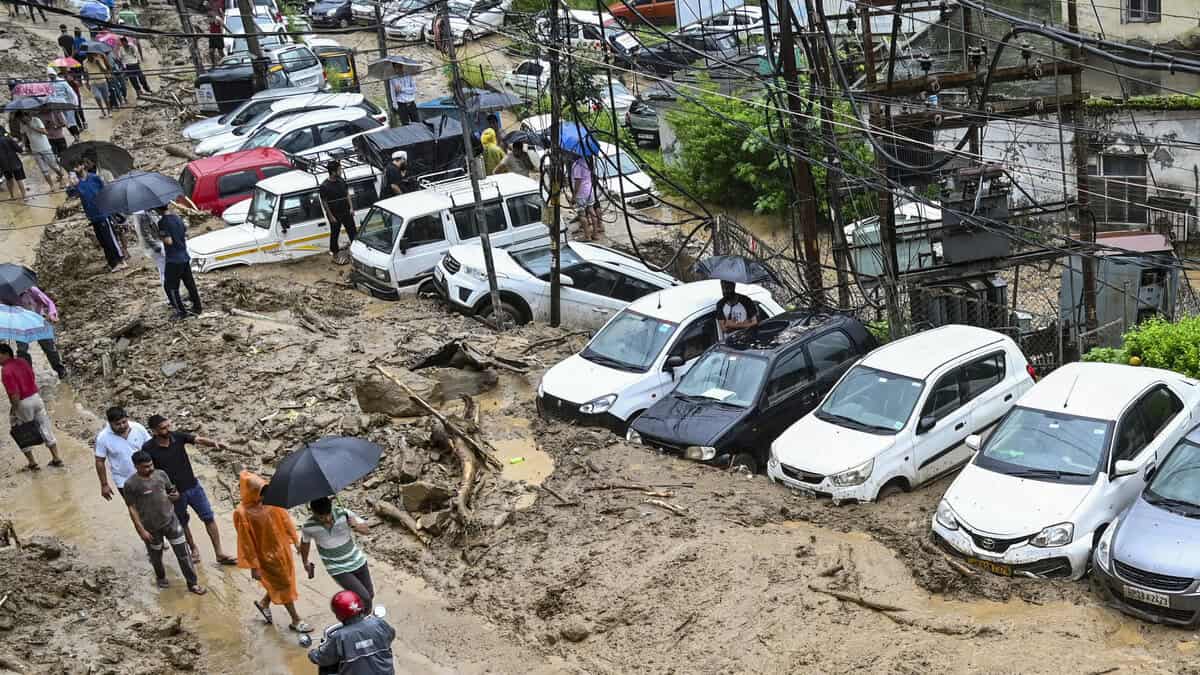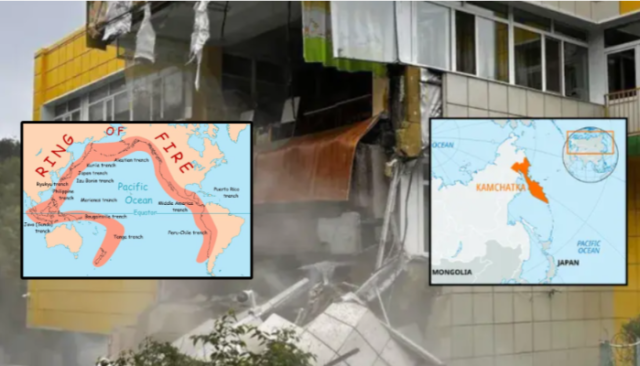The people in Russia were awakened to devastating scenes as one of the most powerful earthquakes in recent memory struck off its far eastern Kamchatka Peninsula, in the early hours of 30th July. Initially, it was recorded at a magnitude of 8.0, however, the United States Geological Survey later revised it to 8.7 (8.8 per some reports).
The sheer intensity and energy exploding from this quake. 😳
8.7 mag earthquake in #Russia. Tsunami warnings and watches. #earthquake #sismo #tsunami #breaking pic.twitter.com/OZtCEvKqdN
— Gerardo Zúñiga (@GEZUPA) July 30, 2025
The quake was registered at a shallow depth of 19.3 kilometres, roughly 125 kilometers southeast of Petropavlovsk-Kamchatsky. It is a city housing 165,000 residents along the coastline of Avacha Bay. The Russian Ministry for Emergency Situations announced that 3 to 4 metres tsunami waves had been observed in some areas of the Kamchatka region.
More Intense Footage Of 8.7M Earthquake & #Tsunami Striking Kamchatka, 🇷🇺 https://t.co/5axbNu0me6 pic.twitter.com/bCYizWtICH
— RT_India (@RT_India_news) July 30, 2025
Countries across Pacific raise alerts
The catastrophe prompted tsunami alerts, warnings and advisories in countries which share the Paciific coast including Philippines, Indonesia, Japan and the United States, among others as Russian officials reported that the earthquake was the strongest in decades. It is tied for the sixth-strongest recorded earthquake and the greatest to shake the planet since 2011, when a 9.0 megaquake hit northeastern Japan.
😰 Tsunami Strikes Kamchatka Following Massive M8.7 Earthquake – Footage Shows Destruction In Its Wake
📹 Unified Geophysical Service of the Russian Academy of Sciences.Kamchatka pic.twitter.com/JHTXNkvub2
— RT_India (@RT_India_news) July 30, 2025
US President Donald Trump urged Americans to be vigilant for tsunami warnings. “Due to a massive earthquake that occurred in the Pacific Ocean, a Tsunami Warning is in effect for those living in Hawaii. A Tsunami Watch is in effect for Alaska and the Pacific Coast of the United States. Japan is also in the way. Stay strong and stay safe,” he expressed.
As tsunami waves lash over the shoreline and transportation is delayed statewide, over 1.9 million people in Japan have been asked to evacuate to safer ground. Furthermore, several South American nations including Chile, Peru, Ecuador and others also issued tsunami warnings alongside Mexico and Panama.
❗️#Tsunami Waves Arrive On Japan’s Coast #Earthquake https://t.co/PawVXXBOs0 pic.twitter.com/JiJ44FjMAg
— RT_India (@RT_India_news) July 30, 2025
On the other hand, the first tsunami waves reportedly reached coastal regions in Japan’s northernmost big island, Hokkaido and Russia’s Kuril Islands. The epicentre of the quake in the shallow depths off the ocean off the Petropavlovsk-Kamchatsky area, falls in the Pacific Ring of Fire.
Pacific Ring of Fire
The Kamchatka Peninsula is located on the famous Pacific “Ring of Fire” which is a chain of volcanoes and earthquake-prone locations around the ocean’s rim. It is home to around 75 per cent of all active volcanoes on Earth and nearly 90 per cent of all earthquakes originate in its vicinity.
The ring isn’t exactly a circle and resembles a horseshoe. It is 40,000-kilometer (25,000-mile) long with a series of 452 volcanoes which run from the southern tip of South America to the North American coast across the Bering Strait down through Japan and into New Zealand.
It extends from southern Chile to the Philippines via the islands off Alaska, Japan, and the west coast of the Americas. A sequence of volcanoes in Indonesia is also included in the ring by some geologists. However, it is “closed” by a number of Antarctic volcanoes both active and dormant.
This belt traces arcs of islands, including the Kuril Islands, the Indonesian archipelago, the Philippines, Japan, the Aleutians, Tonga and the New Hebrides as well as other arc-shaped geomorphic features such as the Andes Mountains and the western coast of North America. It is framed by a sequence of deep ocean troughs with continental landmasses beyond, on the oceanic side.
Interestingly, a sequence of deep ocean trenches that mirror matching volcano arcs along the ring will be exposed if all the water in the Pacific Ocean is drained away. Both islands and continental mountain ranges are formed by these arcs.
The ring houses major volcanic activity
The sliding of a tectonic plate beneath a neighbouring plate, known as subduction, lowers the melting point of rock in the mantle and produces these volcanoes. A volcano is created when the rock transforms into magma, rises to the surface and erupts.
“What’s special about the Ring of Fire is that multiple oceanic plates in the Pacific have subduction boundaries there,” stated a volcanologist at Drexel University in Philadelphia, Loyc Vanderkluysen while talking to Live Science. He added, “About 90% of the 34,000 miles (55,000 kilometers) of subduction plate boundaries on Earth are found in the Pacific.”
He stated that “just due to sheer numbers, the Pacific region is an immense natural laboratory for volcanism, and explosive volcanism in particular” since the ring has approximately two thirds of all volcanoes that have erupted on Earth since 1960.
Plate tectonics formed the Ring of Fire. The mantle is a layer of solid and molten rock on top of which the plates are constantly shifting. They can occasionally slide adjacent to one another, clash or separate. The majority of the ring’s tectonic activity takes place in these geologically active areas. There have been more than 80% of earthquakes with a magnitude of 8.0 or greater there.
Significant locations in the ring
The United States has 65 historically active volcanoes 27 of which are in the Aleutian Islands in Alaska. Notably, the Aleutian Trench is parallel to the Aleutian Islands of Alaska. As the Pacific Plate subducts beneath the North American Plate, both geographical features continue to take shape.
Likewise, the Peru-Chile Trench, formed by the subduction of the Nazca Plate beneath the South American Plate, is parallel to the Andes Mountains of South America. Nevados Ojos del Salado, the highest active volcano in the world which is part of the Andes Mountains. It rises to 6,879 meters (more than 22,500 feet) at the Chile-Argentina boundary.
The East Pacific Rise is recognized as a prominent area of seafloor spreading in the ring while the San Andreas Fault, traversing the central western coast of North America is identified as one of the most active faults on the ring. It is situated on the transform boundary between the northward-moving Pacific Plate and the southward-moving North American Plate.
The 1906 San Francisco earthquake which devastated about 500 city blocks, was caused by movement along the fault. Half of the city’s population was left homeless and almost 3,000 people lost their lives in the earthquake and the ensuing fire.
Hot spots and active volcanoes
Hot spots or places where heat rises from deep inside the Earth’s mantle, are also found in the ring. The Erebus hot spot in Antarctica has Mount Erebus, the planet’s most southern active volcano, situated above its eruptive zone. Since its discovery in 1841, this glacier-covered volcano has been continuously erupting, with a lava lake at its peak.
The western side of the Ring of Fire which stretches from the Kamchatka Peninsula in Russia to the islands of Japan and Southeast Asia to New Zealand, is host to the majority of the active volcanoes. With minor eruptions every year and major eruptions around every 50 years, Mount Ruapehu in New Zealand is one of the more active volcanoes in the ring.
Indonesia’s Krakatau, also called Krakatoa, is an another island volcano. The largest and most well-known mountain in Japan, Mount Fuji, is an active volcano in the ring that last erupted in 1707.
The Aleutian Islands, the Trans-Mexican Volcanic Belt, the Andes Mountains, and the Cascade Mountains in the western United States are among the active volcanic regions found in the eastern portion of the ring. Mount St. Helens is an active volcano in the Cascade Mountains located in the Washington.
Popocatepetl ranks among the most perilous volcanoes in the ring. 15 eruptions have been documented since 1519, making the mountain one of Mexico’s most active volcanoes.
Currently, the earthquake in Russia and the subsequent alerts in other countries have drawn attention to the “Ring of Fire” and the risks associated with locations that are vulnerable to it.

















































